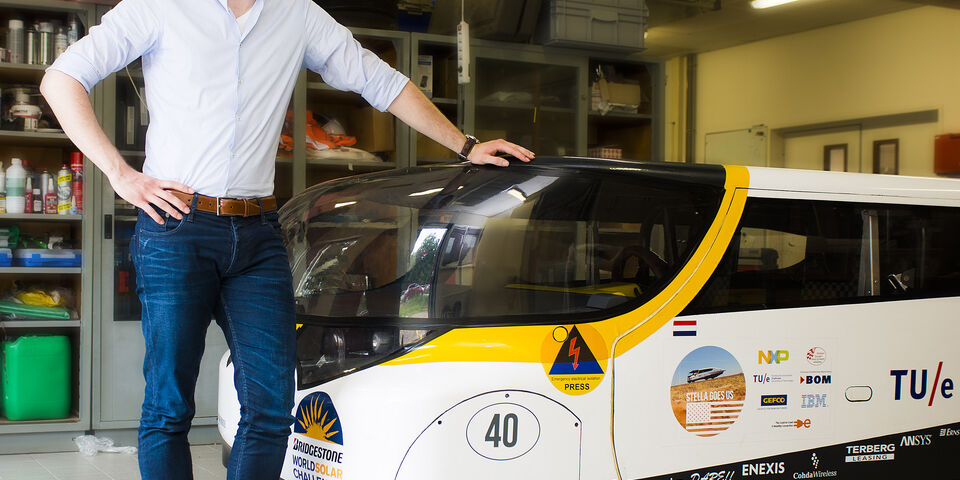Home Stretch | The future of the solar-powered car
Four years ago Roy Cobbenhagen was one of the founding fathers of the Solar Team Eindhoven. Recently he completed his Master’s program of Automotive Technology with a final project within the same student team. Cobbenhagen concludes that a consumer car powered by solar energy also has great potential in Dutch cities – more so than he had expected himself.
What once started as an idea allowing them to postpone their Master’s program for a little while for Roy Cobbenhagen and his fellow student Lex Hoefsloot, has kept haunting him ever since. Stella, the solar-powered family car, won them the World Solar Challenge in 2013 - a race all across Australia covering three thousand kilometers. After having devoted himself to this student project night and day for eighteen months, however, it was time for the technical manager of the first Solar Team Eindhoven to continue his studies. Not surprisingly he decided on the Automotive Technology Master’s program.
His return to the lecture room gave him the opportunity to distance himself from the Solar Team for a bit, he says. “During my Master’s internship, which I did jointly with Lex, we also consciously thought of solar-powered cars as little as possible when we had to analyze current trends in the automotive branch.”
“Of course the Solar Challenge cannot be compared to the Dutch situation”
Nevertheless Cobbenhagen inevitably related everything he learned to Stella and its successor Stella Lux. This was why for his final project he returned to the environment of the Solar Team again: “I now wanted to make an exact calculation of the added value of solar panels on a car for the built environment. For the Solar Challenge our starting point was always a three-thousand-kilometer-long race under a sweltering sun. Of course you cannot compare that to the situation for Dutch consumers, who drive 37 kilometers per day on average in a country less than half as sunny, where cars are standing and moving in the shade for part of the time.”
Cobbenhagen is of opinion that solar panels on electric vehicles should be considered as a ‘range extender’ first and foremost. “Stella Lux, for example, can run five hundred kilometers on its battery; on average you can more than double that range by means of sunlight.” The negative influence of the shade of buildings and trees is not so strong, according to his analysis. “Within Eindhoven an average of thirty percent of the sunlight is blocked; in the country this will be even less. That was a positive surprise for me.”
A big difference with the internal combustion engines that give some electric vehicles a greater range, is that the sun is understandably less reliable than a full fuel tank. For that reason, probability theory was an essential ingredient in the analysis of the solar-powered car pioneer. “I didn’t only want to calculate average values, but also wanted to get a thorough idea of the spread. You want to be able to give confidence intervals, on which the board computer of the car can base its messages.”
All in all Stella Lux could also run almost entirely on solar power in the Netherlands, Cobbenhagen thinks – including charging in the sun in the parking lot. “For a really practical solar-powered car you arrive at about fifty percent of self-generated solar power”, he estimates. The concept shows even more potential than he had imagined himself. Cars powered by solar energy therefore occupy an important place in his plans for the future. “I definitely intend to continue my work in this field; perhaps in the form of a start-up.”


Discussion